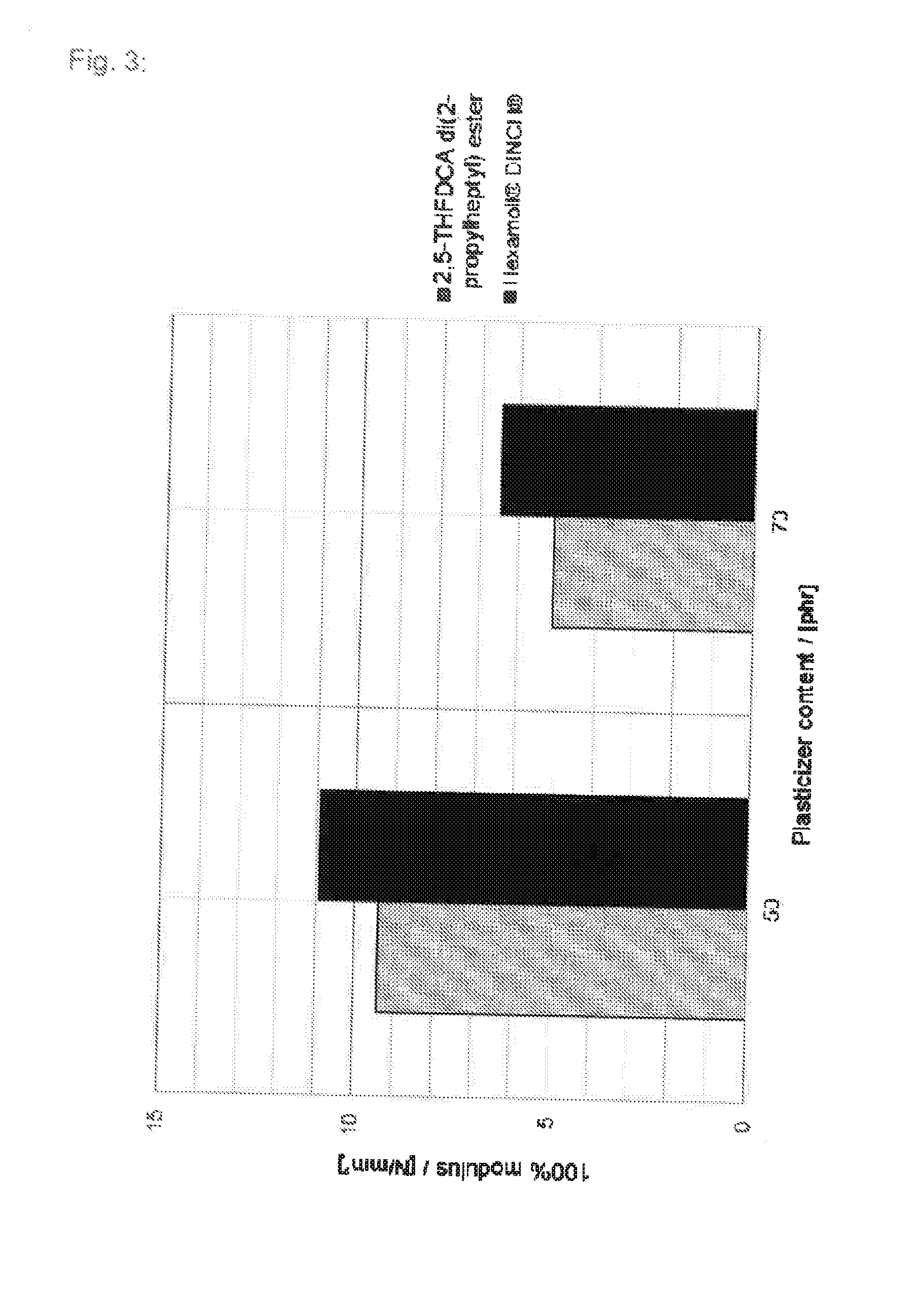Tetrahydrofuran derivatives and their use as plasticizers
a technology of tetrahydrofuran and derivatives, applied in the field of tetrahydrofuran derivatives, to achieve the effects of good suitability, good mechanical properties, and simple and efficien
- Summary
- Abstract
- Description
- Claims
- Application Information
AI Technical Summary
Benefits of technology
Problems solved by technology
Method used
Image
Examples
example 1
Synthesis of di(2-propylhexyl) 2,5-tetrahydrofurandicarboxylate from dimethyl 2,5-furandicarboxylate via transesterification and hydrogenation
example 1.1
Production of dimethyl 2,5-furandicarboxylate (=Step a)
[0364]3.30 kg of methanol were used as initial charge together with 0.10 kg of concentrated sulfuric acid in a 10 L glass reactor equipped with heating jacket, reflux condenser, and mechanical stirrer. 1.6 kg of 2,5-furandicarboxylic acid (2,5-FDCA) were slowly added to this mixture, with vigorous stirring. The dense white suspension that forms was then heated to 70° C. (reflux). The course of the reaction was monitored by means of HPLC analysis, whereupon after about 20 h a clear solution was obtained, with complete conversion of the 2,5-FDCA. The reaction mixture was then cooled to 65° C., and neutralized with saturated NaHCO3 solution and solid NaHCO3 (pH 7). During the neutralization, a dense white suspension again formed, and was cooled to 10° C., stirred for a further 0.5 h, and then filtered by way of a P2 sintered glass frit. The filtercake was washed three times with 1 L of cold water, whereupon about 2 kg of wet solid ...
example 1.2
Catalytic Hydrogenation (=Step b2)
[0366]A 20% by weight solution of dimethyl 2,5-furandicarboxylate in THF was charged to a nitrogen-filled 2.5 L Hastelloy C autoclave from Parr Instrument, equipped with a mechanical stirrer with magnetic coupling, thermocouple, sampling tube, and baffles. 120 g of a heterogeneous Pd / Pt catalyst (0.4% by weight of Pd / 0.4% by weight of Pt on ZrO2, produced by analogy with DE4429014, example 6) were then added, and the nitrogen atmosphere was replaced by a hydrogen atmosphere by filling and ventilating the autoclave with hydrogen three times. The final pressure of hydrogen was increased to 200 bar, and the autoclave was heated to 180° C. The progress of the reaction was monitored by means of GC analysis. After complete conversion (usually after from 40 to 60 hours), the autoclave was cooled and ventilated, and the contents were filtered in order to remove the solid catalyst. The solvent in the filtrate was then removed by distillation under reduced pr...
PUM
| Property | Measurement | Unit |
|---|---|---|
| time | aaaaa | aaaaa |
| tensile strain at break | aaaaa | aaaaa |
| solvation temperature | aaaaa | aaaaa |
Abstract
Description
Claims
Application Information
 Login to View More
Login to View More - R&D
- Intellectual Property
- Life Sciences
- Materials
- Tech Scout
- Unparalleled Data Quality
- Higher Quality Content
- 60% Fewer Hallucinations
Browse by: Latest US Patents, China's latest patents, Technical Efficacy Thesaurus, Application Domain, Technology Topic, Popular Technical Reports.
© 2025 PatSnap. All rights reserved.Legal|Privacy policy|Modern Slavery Act Transparency Statement|Sitemap|About US| Contact US: help@patsnap.com



